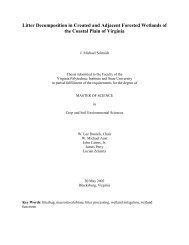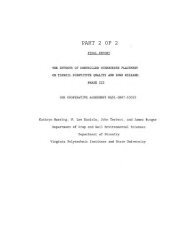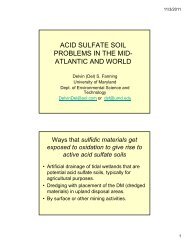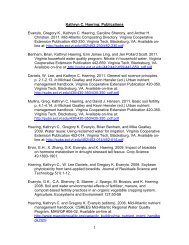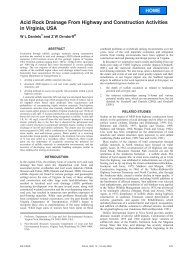Remediation of PAH-Contaminated Soils and Sediments: A ...
Remediation of PAH-Contaminated Soils and Sediments: A ...
Remediation of PAH-Contaminated Soils and Sediments: A ...
You also want an ePaper? Increase the reach of your titles
YUMPU automatically turns print PDFs into web optimized ePapers that Google loves.
<strong>PAH</strong> in humans<br />
The carcinogenicity <strong>of</strong> <strong>PAH</strong>s was first discovered in the mid-1930’s <strong>and</strong> gave way<br />
to new research on the influences <strong>of</strong> <strong>PAH</strong>s on human health <strong>and</strong> the<br />
environment. Data concerning human exposure <strong>and</strong> carcinogenicity <strong>of</strong> <strong>PAH</strong>s<br />
have been from occupational workers exposed to <strong>PAH</strong>s during coke production,<br />
ro<strong>of</strong>ing, oil refining <strong>and</strong> coal gasification (Wynder <strong>and</strong> H<strong>of</strong>fman, 1967; Lloyd,<br />
1971; Mazumdar et al., 1975; Hammond et al., 1976; Maclure <strong>and</strong> MacMahon,<br />
1980). However, human exposure is not limited to inhalation, absorption or<br />
ingestion through working environments. Nearly every person is exposed to<br />
<strong>PAH</strong>s on a daily basis due to widespread atmospheric distribution.<br />
As stated earlier, <strong>PAH</strong> concentrations are generally higher in the winter months<br />
as a result <strong>of</strong> fossil fuel combustion (Harvey, 1997), making human exposure<br />
during this time higher than in summer months. Particulate matter containing<br />
<strong>PAH</strong>s are a major contributor to accumulation <strong>of</strong> <strong>PAH</strong>s in urban areas. A study<br />
in Taiwan found human exposure through inhalation to be between 0.4 <strong>and</strong> 1.55<br />
ng day -1 (Kuo et al., 2003). Menzie et al. (1992) found <strong>PAH</strong> levels to be 15-50 ng<br />
m -3 in urban areas. In addition to particulate matter, inhalation <strong>of</strong> cigarette smoke<br />
greatly increases human exposure to <strong>PAH</strong>s. Tobacco smoke contains more than<br />
150 compounds in the gas phase <strong>and</strong> >2000 in the particulate phase (Harvey,<br />
1997), making tobacco use the single greatest factor contributing to respiratory<br />
cancers. Humans are also exposed to <strong>PAH</strong>s through ingestion <strong>and</strong> absorption.<br />
Drinking water has been found to contain 1-10 ng <strong>PAH</strong> L -1 <strong>and</strong> high levels (10’s<br />
<strong>of</strong> ng <strong>PAH</strong> kg -1 ) have been found in leafy vegetables, grains, fats, oils, grilled <strong>and</strong><br />
smoked meats (Menzie et al., 1992). It is suspected that humans inhale, ingest<br />
<strong>and</strong> absorb 1-5 ng <strong>PAH</strong> per day from food, 0.02-3.0 ng <strong>PAH</strong> per day from air,<br />
<strong>and</strong> 0.0002-0.12 ng <strong>PAH</strong> per day from water (Menzie et al., 1992).<br />
15



